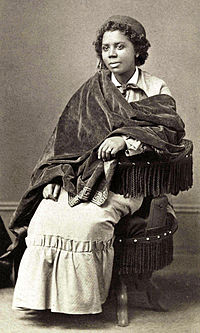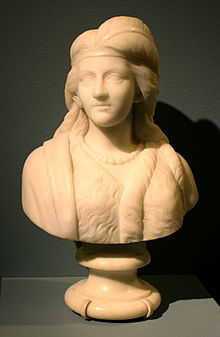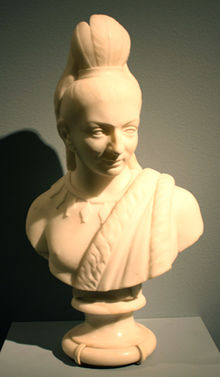- Edmonia Lewis
-
Edmonia Lewis 
Edmonia LewisBirth name Mary Edmonia Lewis Born July 4, 1844
Albany, New YorkDied September 17, 1907
London, EnglandNationality American Field Sculpture Training Oberlin College Movement Neoclassicism Patrons Ulysses S. Grant Influenced by Edmund Brackett Mary Edmonia Lewis (July 4, 1844–September 17, 1907) was the first African American and Native American woman to gain fame and recognition as a sculptor in the international fine arts world. She was of African American, Haitian and Ojibwe descent.
Contents
Biography
Early life and education
Lewis's 21 August 1865 passport application states that she was born on 4 July 1844 in Greenbush, New York, which is now the City of Rensselaer.[1] Her inspiration for much of her artwork came from her ethnic background. Lewis' father was Haitian of African descent, while her mother was of Mississauga Ojibwe and African descent.[2] Lewis’ mother was known as an excellent weaver and craftswoman.[3]
When Lewis was around nine years old, both of her parents died within a year of each other.[4] Lewis and her older brother, Samuel, lived with their mother’s sisters for the next three years. Lewis and her aunts sold Ojibwe baskets and other crafts to tourists visiting Niagara Falls, Toronto, and Buffalo.[5] Samuel became a successful businessman and gold prospector and paid for her tuition to the New York Central College.[5] Lewis was rebellious and did not learn English well, so Samuel suggested she transfer to Oberlin College, outside Cleveland, Ohio.[6]
At the time, Oberlin College was one of the first higher learning institutions in the United States to admit women and people of differing ethnicities. Lewis' decision to attend Oberlin was one that would significantly change her life, as that is where Lewis began her art studies.[7]
Incident at Oberlin College
During the winter season of 1862, several months after the start of the Civil War, while Edmonia Lewis attended Oberlin College, an incident involved her and two classmates, Maria Miles and Christina Ennes. The three women, who boarded in the home of Oberlin trustee John Keep, planned to go sleigh riding with some young men later that day. Before the sleighing Lewis served her friends a drink of spiced wine. Shortly after, Miles and Ennes fell severely ill. Doctors examined them and concluded that the two women had some sort of poison in their system, apparently cantharides, a reputed aphrodisiac. For a time it was not certain that they would survive. Days later, it became apparent that the two women would recover from the incident, and, because of their recovery, the authorities initially took no action.
However, townspeople took matters in their own hands. Walking home alone one night, Lewis was dragged into an open field by unknown assailants and badly beaten.[8] Those responsible for her injuries were never found.[9] Due to the attack, local authorities arrested Lewis, charging her with poisoning her friends. The college defended their student throughout the trial. John Mercer Langston, an Oberlin College alumnus, and only practicing African-American lawyer in Oberlin, represented Lewis during her trial. Although most witnesses spoke against Lewis and Lewis did not testify, Langston did an excellent job. Lewis was found not guilty of the charges.[8]
Art career
After college, Lewis moved to Boston late in 1863.[10] She began to study under a well-known sculptor, Edward Augustus Brackett. Under his tutelage, Lewis crafted her own sculpting tools and sold her first piece, a sculpture of a woman’s hand, for $8.[11] She opened her studio to the public in her first solo exhibit in 1864.[12]
She found inspiration in the lives of Abolitionists and Civil War heroes. Lewis met Union Colonel Robert Gould Shaw, the commander of an African American Civil War regiment from Massachusetts. She was inspired to create a bust of his likeness, which impressed the Shaw family, who purchased her homage.[13] Poet Anna Quincy Waterston was inspired to write a poem about both Lewis and Shaw.[14]
Early works that proved highly popular included medallion portraits of the abolitionists John Brown and William Lloyd Garrison. Lewis also drew inspiration from Henry Wadsworth Longfellow and his work, particularly his epic poem, "The Song of Hiawatha."
Lewis was determined to study in Rome and sailed there in 1865.[7][15] On her 1865 passport is written, "M. Edmonia Lewis is a Black girl sent by subscription to Italy having displayed great talents as a sculptor".[16] Established sculptor Hiram Powers gave Lewis space in his studio.[15] She entered a circle of expatriate artists and established her own space within the former studio of 18th-century Italian sculptor Antonio Canova.[17]
Rome was where Lewis spent most of her adult career. Her studies there contributed to her neoclassical techniques and subject matter. The surroundings of the classical world greatly inspired Lewis and influenced her work. Lewis recreated the classical art style in her own work. For instance, she presented people in her sculptures as draped in robes rather than in contemporary clothing.[18]
Her work sold for large sums of money. In 1873 an article in the New Orleans Picayune stated, “Edmonia Lewis had snared two 50,000 dollar commissions.” Her new-found popularity made her studio a tourist destination.[19] Lewis had many major exhibitions during her rise to fame, including one in Chicago, Illinois in 1870, and in Rome in 1871.[7]
A major coup in her career was participating in the 1876 Centennial Exposition in Philadelphia.[20] For this, she created a monumental 3,015-pound marble sculpture, The Death of Cleopatra, which dramatically portrayed the queen in the throes of death.[21] Of the piece, J. S. Ingraham wrote that Cleopatra was “the most remarkable piece of sculpture in the American section” of the Exposition.[22] Much of the viewing public was shocked by Lewis’ frank portrayal of death, but the statue drew thousands of viewers.[23] After being placed in storage, the statue was lost. After 120 years, it was discovered in a Sotheby’s auction. After authentication, it was donated to the Smithsonian American Art Museum.[24]
A testament to Lewis' renown as an artist came in 1877, when former US President Ulysses S. Grant commissioned her to do his portrait. He sat for her as a model and was pleased with her finished piece.[25]
In the late 1880s, the neoclassical genre became less popular, and Lewis's popularity also declined. She continued to work in marble, increasingly creating altarpieces and other works for Roman Catholic patrons. In the art world, she became eclipsed by history and lost fame. The events of her later years are not known.[7]
Death
For years, the year of Edmonia Lewis’ death was speculated to be 1911 in Rome. An alternative view held that she died in Marin County, California and was buried in an unmarked grave in San Francisco.[26] However, recent scholarship reveals that she lived in Hammersmith area of London, England before her death on September 17, 1907 in the Hammersmith Borough Infirmary.[27]
Lewis never married and had no known children.[28] In 2002, scholar Molefi Kete Asante listed Edmonia Lewis on his list of 100 Greatest African Americans.[29]
Work
Descriptions of most popular works
Forever Free, 1867
This sculpture is of white marble. It represents a man standing, staring up, and raising his left arm into the air. Wrapped around his left wrist is a chain; however, this chain is not restraining him. To his right is a woman kneeling with her hands held in a prayer position. The man’s right hand is gently placed on her right shoulder. Forever Free represents the emancipation of African-American slaves after the Civil War. Lewis attempted to break stereotypes of African-American women with this sculpture. For example, Lewis portrayed the woman as completely dressed while the man was partially dressed. This drew attention away from the notion of African-American women being sexual figures. This sculpture also symbolizes the end of the Civil War. While African Americans were technically free, they continued to be restrained, shown by the fact that the couple had chains wrapped around their bodies. This piece is held by Howard University Gallery of Art in Washington, D.C. [30]Hagar, 1868
Inspired by a character from the Old Testament, this was made of white marble. It shows Hagar with her hands in prayer and staring slightly up but not straight across. The Egyptian wife of Abraham, Hagar gave birth to his first son Ishmael. Abraham’s second wife, Sarah, resented Hagar and “cast Hagar into the wilderness after the birth Sarah’s son Isaac.” Lewis uses Hagar to symbolize the African mother in the United States. She represented the abuse of African women. Lewis had a tendency to sculpt historically strong women. We see this not just in Hagar but also in Lewis's Cleopatra piece. Lewis also depicted regular women in great situations, emphasizing their strength.[28]Old Arrow-Maker and his Daughter, 1866
This sculpture was inspired by Lewis's Native American heritage. An arrow-maker and his daughter sit on a round base. They are dressed in traditional Native American clothes and have recognizable Native American facial features. Lewis pushed the limits with the accuracy of her sculptures. Lewis never generalized the appearance of those she sculpted. Instead, she found truth in the particular and used that in her work. She wanted to be as realistic as possible.[28]List of major, known artworks
- John Brown medallions, 1864-5
- Colonel Robert Gould Shaw (plaster), 1864
- Anne Quincy Waterston, 1866
- A Freed Woman and Her Child, 1866
- The Old Arrow-Maker and His Daughter, 1866
- The Marriage of Hiawatha, 1866-7
- Forever Free, 1867
- Colonel Robert Gould Shaw (marble), 1867-8
- Hagar in the Wilderness, 1868
- Madonna Holding the Christ Child, 1869
- Hiawatha, 1868[31]
- Minnehaha, 1868[31]
- Henry Wordsworth Longfellow, 1869–1871
- bust of Abraham Lincoln, 1870
- Asleep, 1872
- Awake, 1872
- Poor Cupid, 1873
- Moses, 1873
- Hygieia, 1874
- Hagar, 1875
- The Death of Cleopatra, marble, 1876
- John Brown, 1876, Rome (plaster bust)
- Henry Wadsworth Longfellow, 1876, Rome (plaster bust)
- General Ulysses S. Grant, 1877–1878
- Veiled Bride of Spring 1878
- John Brown, 1878–1879
- The Adoration of the Magi, 1883[32]
Posthumous exhibits
- Art of the American Negro Exhibition, Chicago, 1940
- Howard University, Washington D.C., 1967
- Vassar College, New York, 1972
- Michael Rosenfeld Gallery, New York, 2008
Notes
- ^ Passport application 21933 accessed on Ancestry.com on 1 November 2011
- ^ Wolfe, 12
- ^ Wolfe, 15
- ^ Wolfe, 18
- ^ a b Wolfe, 19
- ^ Wolfe, 20
- ^ a b c d Plowden, Martha W. "Edmonia Lewis-Sculptor." Famous Firsts of Black Women. Gretna: Pelican Company, 1994.
- ^ a b Katz, William L. and Paula A. Franklin. "Edmonia Lewis: Sculptor." Proudly Red and Black. New York: Maxwell Macmillan, 1993.
- ^ Woods, Naurice F. "Mary Edmonia Lewis." Insuperable Obstacles. Cincinnati: Union Institute Graduate School, 1993
- ^ Wolfe, 41
- ^ Wolfe, 43
- ^ Wolfe, 44
- ^ Wolfe, 46-9
- ^ Wolfe, 49
- ^ a b Wolfe, 53
- ^ Passport application 21933 accessed on Ancestry.com on 1 November 2011
- ^ Wolfe, 55
- ^ Lewis, Samella. "The Diverse Quests for Professional Statues" in African American Art and Artists. Berkeley: University of California Press, 2003.
- ^ Tufts, Eleanor. "The Nineteenth Century", Our Hidden Heritage. New York: Paddington P, 1974.
- ^ Wolfe, 93
- ^ Wolfe, 97, 102
- ^ Wolfe, 97-99
- ^ Wolfe, 100
- ^ Wolfe, 102-105
- ^ Wolfe, 108-109
- ^ Wolfe, 110
- ^ "Sculptor's Death Unearthed: Edmonia Lewis Died in London in 1907." Cowan's Auctions: News. (retrieved 14 March 2011)
- ^ a b c Perry, Regenia A. "Edmonia Lewis", Free Within Ourselves. Washington D.C.: National Museum of American Art, 1992.
- ^ Asante, Molefi Kete (2002). 100 Greatest African Americans: A Biographical Encyclopedia. Amherst, New York. Prometheus Books. ISBN 1-57392-963-8.
- ^ Collins, Lisa G. "Female Body in Art." The Art of History. New Jersey: Rutgers University Press, 2002.
- ^ a b According to the Newark Museum; 1869-1871, according to Wolfe, 120
- ^ Wolfe, 120
References
- Romare Bearden & Henderson, Harry. "A History of African-American Artists (From 1792 to the Present)", Pantheon Books (Random House), 1993. ISBN 0-394-57016-2
- Collins, Lisa G. "Female Body in Art." The Art of History. New Jersey: Rutgers University Press, 2002.
- Katz, William L., and Paula A. Franklin. "Edmonia Lewis: Sculptor." Proudly Red and Black. New York: Maxwell Macmillan, 1993.
- Lewis, Samella. "The Diverse Quests for Professional Statues" in African American Art and Artists. Berkeley: University of California Press, 2003.
- Perry, Regenia A. "Edmonia Lewis." Free Within Ourselves. Washington D.C.: National Museum of American Art, 1992.
- Plowden, Martha W. "Edmonia Lewis-Sculptor." Famous Firsts of Black Women. Gretna: Pelican Company, 1994.
- Tufts, Eleanor. "The Nineteenth Century." Our Hidden Heritage. New York: Paddington Press, 1974.
- Wolfe, Rinna Evelyn. ‘’Edmonia Lewis: Wildfire in Marble.’’ Parsippany, New Jersey, 1998. ISBN 0-382-39714-2.
- Woods, Naurice F. "Mary Edmonia Lewis." Insuperable Obstacles. Cincinnati: Union Institute Graduate School, 1993.
External links
- Edmonia Lewis at www.edmonialewis.com
- Edmonia Lewis biography at www.lkwdpl.org
- "Edmonia Lewis, African American and Native American Sculptor", womenshistory.about.com
- "The Object at Hand", Smithsonian Magazine
Additional reading
- Richardson, Marilyn. "Vita: Edmonia Lewis." Harvard Magazine, 1986.
- Richardson, Marilyn, "Edmonia Lewis." American National Biography, National Council of Learned Societies, 1999.
- Richardson, Marilyn, "Edmonia Lewis." Encyclopedia of African American Culture and History" Columbia University, 1996.
Categories:- 1845 births
- 1907 deaths
- Ojibwe people
- American people of Haitian descent
- African American artists
- Native American sculptors
- People from Albany, New York
- Artists from New York
- American women artists
Wikimedia Foundation. 2010.



